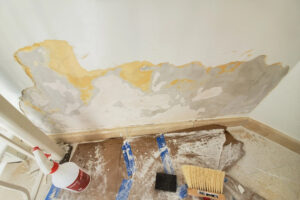 Plaster walls, a common feature in older homes, add character and charm to any space. However, over time, cracks, holes, and other damages may occur, requiring repair and restoration. In this comprehensive guide, we will walk you through the process of repairing plaster walls, providing expert tips and techniques to ensure a successful outcome. Whether you are dealing with cracks or holes in the plaster, this guide will equip you with the knowledge and skills that can possibly help you restore your walls to their former glory. IN MOST CASES… it’s best to have a professional repair your plaster walls for you.
Plaster walls, a common feature in older homes, add character and charm to any space. However, over time, cracks, holes, and other damages may occur, requiring repair and restoration. In this comprehensive guide, we will walk you through the process of repairing plaster walls, providing expert tips and techniques to ensure a successful outcome. Whether you are dealing with cracks or holes in the plaster, this guide will equip you with the knowledge and skills that can possibly help you restore your walls to their former glory. IN MOST CASES… it’s best to have a professional repair your plaster walls for you.
Understanding Plaster Walls
Before we dive into the repair process, let’s take a moment to understand plaster walls. Plaster walls consist of a combination of plaster and lath, which is a wooden framework that provides support for the plaster. The plaster is applied in layers, creating a smooth and durable surface. Over time, factors such as settling, changes in temperature, and general wear and tear can lead to cracks and holes in the plaster. Understanding the structure of plaster walls will help you navigate the repair process effectively.
Tools and Materials
To repair plaster walls, you will need a few essential tools and materials. Here’s a list of items you should have on hand before you begin:
- Putty knife or plaster spreader
- Sandpaper or sanding block
- Plaster adhesive or bonding agent
- Plaster patching compound
- Joint compound
- Paintbrush
- Taping knife
- Drywall screws
- Drill with a masonry bit
- Plastic drop cloths
- Painter’s tape
- Shop vacuum
- Safety goggles
- Dust mask or respirator
Having these tools and materials ready will ensure a smooth and efficient repair process.
Repairing Cracks in Plaster Walls
Step 1: Prepare the Room
Before you start repairing the cracks, it’s essential to prepare the room. Cover the floor with plastic drop cloths and secure them in place with painter’s tape. This will protect the floor from any spilled or splattered plaster or joint compound. Close off the room using plastic sheeting and painter’s tape to prevent sanding dust from spreading to other areas. It’s also a good idea to cover vents to prevent dust from entering the HVAC system.
Step 2: Assess and Prepare the Cracks
Start by examining the cracks in your plaster walls. Use a putty knife or plaster spreader to smooth and remove any loose plaster pieces and jagged edges around the cracks. Wipe away dust and debris with a cloth or rag. Dampen the area with a spray bottle filled with water. This will help the new plaster adhere to the surface.
Step 3: Apply Plaster Patching Compound
Follow the manufacturer’s instructions to mix the dry plaster patching compound with water in a large bucket. Transfer the mixed plaster into a mud pan for easy application. Use a 4″ wallboard knife to apply a layer of plaster to the crack, ensuring it is even with the rest of the wall. For most crack repairs, one layer of plaster is sufficient. Allow the area to dry for at least 24 hours.
Step 4: Sand and Finish
Once the repaired area is dry, use sandpaper or a sanding block to smooth it down until it is flush with the surrounding wall. Wipe away any dust with a damp cloth or sponge. At this stage, you can prime and paint the repaired area to match the rest of the wall. Use a paintbrush to apply a primer/sealer and let it dry. Then, apply your desired paint color, following the manufacturer’s instructions.
Repairing Holes in Plaster Walls
Step 1: Remove Damaged Plaster
If you have holes in your plaster walls, the first step is to remove the damaged plaster. Use a cold chisel and a ball peen hammer to chip away the damaged plaster. Be careful not to damage the underlying lath. Use a utility knife to smooth the inside edges of the hole and prepare it for repair.
Step 2: Apply Plaster Adhesive
To ensure a strong bond between the new plaster and the lath, apply a plaster adhesive or bonding agent to the exposed lath and the edges of the hole. Use a paintbrush to evenly coat the surfaces with the adhesive. This step will prevent the new plaster from cracking or delaminating.
Step 3: Apply Base Coat
Mix the plaster base coat according to the manufacturer’s instructions. Using a trowel, apply the base coat to the hole, pressing it firmly against the lath. Ensure that the base coat fills the hole completely and is flush with the surrounding wall. Use a scarifier to create shallow grooves in the base coat, improving adhesion for the next layer.
Step 4: Apply Finish Coats
After the base coat has dried, mix the finish plaster according to the manufacturer’s instructions. Apply a thin layer of finish plaster over the base coat, feathering the edges to blend with the surrounding wall. Allow each layer to dry before applying the next. Depending on the size of the hole, you may need to apply multiple layers of finish plaster to achieve a seamless repair.
Step 5: Sand and Paint
Once the final layer of finish plaster is dry, use sandpaper to smooth the repaired area until it is flush with the rest of the wall. Wipe away any dust with a damp cloth or sponge. Apply a primer/sealer to the repaired area and let it dry. Finally, paint the area to match the rest of the wall, following the manufacturer’s instructions.
Repairing Lath in Plaster Walls
Step 1: Insert Metal Lath
If the lath behind a hole is damaged, you will need to insert metal lath for reinforcement. Cut out the damaged wood lath using a keyhole saw or chisel and mallet. Take a piece of metal lath, insert a wire loop at the center, and press it firmly against the inside of the hole. Secure the metal lath by twisting the wire tightly around a wooden dowel.
Step 2: Apply Plaster
Mix plaster according to the manufacturer’s instructions and apply it over the metal lath. Use a trowel to smooth the plaster and fill the hole completely. Cross-scratch the first coat of plaster to create grooves that will help the second coat adhere. Allow the plaster to dry for 24 hours.
Step 3: Coat with Joint Compound
Once the plaster is dry, remove the wooden dowel and cut the wire with wire cutters. Apply a thin layer of joint compound over the repaired area, feathering the edges to blend with the surrounding wall. Let the joint compound dry and then sand it smooth with fine-grit sandpaper. The repaired area is now ready for priming and painting.
For best results call a professional who does these repairs every day or month. Repairing plaster walls may require time and skill, but it is a rewarding process that can restore the beauty and integrity of your walls. By following the steps outlined in this comprehensive guide, you can confidently tackle cracks, holes, and damaged lath, ensuring a successful repair. Remember to gather the necessary tools and materials, prepare the room, and follow each step carefully. With patience and attention to detail, you can achieve professional-looking results and enjoy the beauty of your restored plaster walls for years to come.
Contact Us (513) 769-5044 for a Consultation!
About Business Concepts Remodeling

Building Concepts specializes in custom remodeling projects across the Greater Cincinnati Area. Our comprehensive residential and commercial experience has built a reliable reputation you can trust. Everyday we work to build trust through communication and attention to detail. We strive to enhance the lives of our clients by providing high quality solutions with hands on service. Throughout the remodeling project, minimal disruption to your home or office is our highest priority.
> Learn More
